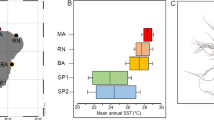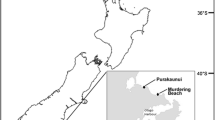Abstract
Genetic differentiation of Laminaria longicruris populations has been demonstrated in nitrate-poor (St. Margaret's Bay) and nitrate-rich (Bay of Fundy) regions of Nova Scotia, Canada. At 9°C half-saturation constants for growth (Ks) were smaller (1.1 μM NO -3 ) for St. Margaret's Bay plants than for plants from the Bay of Fundy (2.3 μM NO -3 ). Maximum specific growth rate (μmax) and maximum uptake rate (Vmax) were higher for St. Margaret's Bay than for Fundy plants. However half-saturation constants for nitrate uptake (Km) were similar for plants from the two populations. The capacity to accumulate nitrate in an internal tissue pool was larger in St. Margaret's Bay plants than in Fundy plants. The differences among the populations are thought to be adaptive responses to the local nitrate environments.
Similar content being viewed by others
Literature cited
Anderson, M. R., A. Cardinal and J. Larochelle: An alternate growth pattern of Laminaria logicruris. J. Phycol. 17, 405–411 (1981)
Bollman, R. C. and G. G. C. Robinson: The kinetics of organic acid uptake by three Chlorophyta in axenic culture. J. Phycol. 13, 1–5 (1977)
Bolton, J. J.: Estuarine adaptation in populations of Pilayella littoralis (L.) Kjellm. (Phaeophyta, Ectocarpales). Estuar. coast. mar. Sci. 9, 273–280 (1979)
Carpenter, E. J. and R. R. L. Guillard: Intraspecific differences in the nitrate half-saturation constants for three species of marine phytoplankton. Ecology 52, 183–185 (1971)
Chapin, F. S., III: The mineral nutrition of wild plants. Ann. Rev. Ecol. Syst. 11, 233–260 (1980)
Chapman, A. R. O.: Methods for macroscopic algae. In: Handbook of phycological methods. Culture methods and growth measurements, pp 88–104 Ed. by J. R. Stein. Cambridge: Cambridge 1973
Chapman, A. R. O. and J. A. Gagné: Environmental control of kelp growth in St. Margaret's Bay and on the south-west shore of Nova Scotia. Can. Tech. Rept., fish. aquat. Sci. 954, 194–207 (1980)
Chapman, A. R. O. and J. S. Craigie: Seasonal growth in Laminaria longicruris: relations with dissolved inorganic nutrients and internal reserves of nitrogen. Mar. Biol. 40, 197–205 (1977)
Chapman, A. R. O., J. W. Markham and K. Lüning: Effects of nitrate concentration on the growth and physiology of Laminaria saccharina (Phaeophyta) in culture. J. Phycol. 14, 195–198 (1978)
Cleland, W. W.: The statistical analysis of enzyme kinetic data. Adv. Enzymol. 29, 1–32 (1967)
Davis, P. H. and V. H. Heywood: Principles of angiosperm taxonomy, 556 pp. Edinburgh and London: Oliver and Boyd 1963
Daubenmire, R. F.: Plants and environment, 422 pp. New York: Wiley 1974
Dugdale, R. C.: Nutrient cycles. In: The ecology of the seas, pp 141–172. Ed. by D. H. Cushing and J. J. Walsh. Philadelphia: Saunders 1976
Gagné, J. A., K. H. Mann and A. R. O. Chapman: Seasonal pattern of growth and storage in Laminaria longicrusis in relation to differing patterns of availability of nitrogen in the water. Mar. Biol. 69, 91–101 (1982)
Gerard, V. A. and K. H. Mann: Growth and production of Laminaria longicruris (Phaeophyta) populations exposed to different intensities of water movement. J. Phycol. 15, 33–41 (1979)
Guillard, R. R. L., P. Kilham, and T. A. Jackson: Kinetics of silicon-limited growth in the marine diatom Thalassiosira pseudonana Hasle and Heimdal (=Cyclotella nana Husted). J. Phycol. 9, 233–237 (1973)
Healey, F. P.: Slope of the Monod equation as an indicator of advantage in nutrient competition. Microb. Ecol. 5, 281–286 (1980)
Kain, J. M.: Synopsis of biological data on Laminaria hyperborea. FAO Fish. Synops. 87, 66 pp. 1971
Kilham, S. S.: Kinetics of silicon-limited growth in the freshwater diatom Asterionella formosa. J. Phycol. 11, 396–399 (1975)
Lüning, K.: Control of algal life-history by day-length and temperature. Syst. Assoc. sp. vol. 17(b), 915–945 (1980)
Nelson, D. M., J. J. Goering, S. S. Kilham and R. R. L. Guilard: Kinetics of silic acid uptake and rates of silica dissolution in the marine diatom Thalassiosira pseudonana. J. Phycol. 12, 246–252 (1976)
Probyn, T. A. and A. R. O. Chapman: Nitrogen uptake characteristics of Chordaria flagelliformis (Phaeophyta) in batch mode and continuous mode experiments. Mar. Biol. 71, 129–133 (1982)
Provasoli, L.: Media and prospects for the cultivation of marine algae. In: Cultures and collections of algae. Proc. U.S.—Japan Conf. Hakone, September 1966, pp 63–75. Ed. by I. A. Watanabe and A. Hattori. Tokyo: Jap. Soc. Plant Physiol 1968
Reed, R. H. and G. Russell: Adaptation to salinity stress in populations of Enteromorpha intestinalis (L.) Link. Estuar. coast. mar. Sci. 8, 251–258 (1979)
Rhee, G.-Y.: Continuous culture in the phytoplankton ecology. Adv. Microbiol. 2, 151–203 (1980)
Russell, G.: A study in populations of Pylaiella littoralis. J. mar. biol. Ass. U.K. 43, 469–483 (1963)
Russell, G. and J. J. Bolton: Euryhaline ecotypes of Ectocarpus siliculosus (Dillw.) Lyngb. Estuar. coast. mar. Sci. 3, 91–94 (1975)
Russell, G. and O. P. Morris: Copper tolerance in the marine fouling alga Ectocarpus siliculosus. Nature, Lond. 228, 288–289 (1970)
Russell, G. and O. P. Morris: Ship fouling as an evolutionary process. In: Proc. 3rd, Int. Congress on marine corrosion and fouling, pp 719–730. Ed. by R. F. Acker, B. F. Brown, J. R. DePalma and W. P. Iverson: Evanston: Northwestern University Press 1973
Strickland, J. D. H. and T. R. Parsons: A practical handbook of seawater analysis. Bull. Fish. Res. Bd Can. 125, 61–69 (1960)
Syrett, P. J.: Nitrogen metabolism of microalgae. Can. Bull. fish. aquat. Sci. 210, 182–210 (1981)
Underhill, P. A.: Nitrate uptake kinetics and clonal variability in the neritic diatom Biddulphia aurita. J. Phycol. 13, 170–176 (1977)
Wallen, D. G. and L. D. Carter: Molybdenum dependence, nitrate uptake and photosynthesis of freshwater plankton algae. J. Phycol. 11, 345–349 (1975)
Wilkinson, M.: Investigation on the autecology of Eugomontia sacculata Kornm., a shell-boring alga. J. exp. mar. Biol. Ecol. 15, 19–27 (1974)
Yarish, C., P. Edwards and S. Casey: A culture study of salinity responses in ecotypes of two estuarine red algae. J. Phycol. 15, 341–346 (1979)
Author information
Authors and Affiliations
Additional information
Communicated by R. O. Fournier, Halifax
Rights and permissions
About this article
Cite this article
Espinoza, J., Chapman, A.R.O. Ecotypic differentiation of Laminaria longicruris in relation to seawater nitrate concentration. Mar. Biol. 74, 213–218 (1983). https://doi.org/10.1007/BF00413924
Accepted:
Issue Date:
DOI: https://doi.org/10.1007/BF00413924




